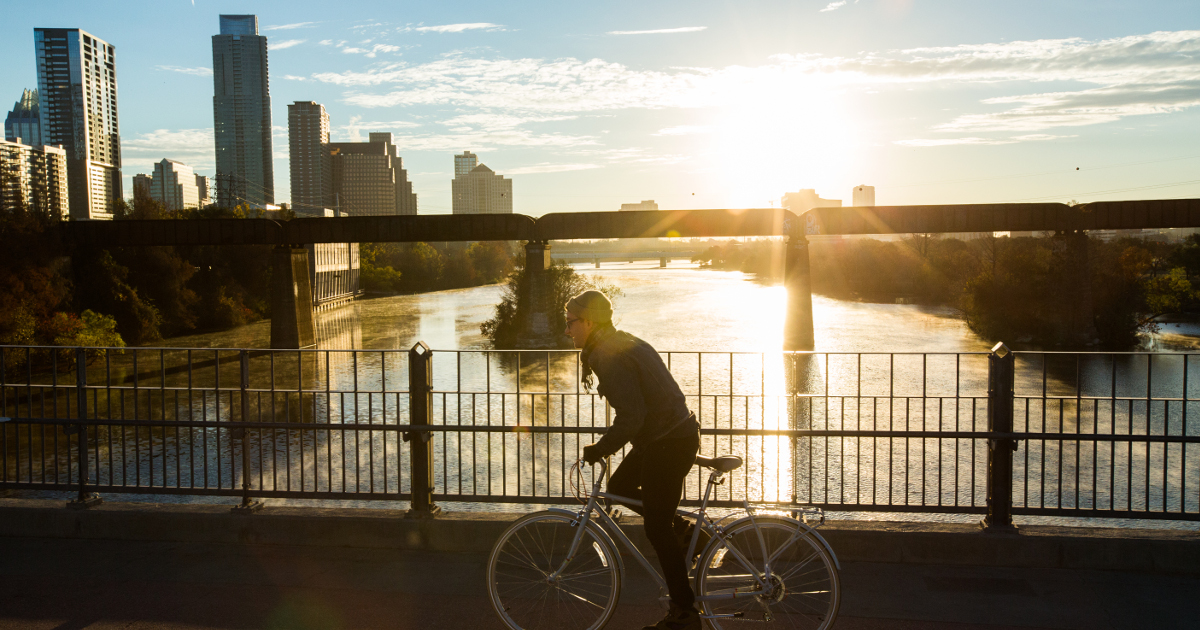PlacesForBikes is a PeopleForBikes program to help U.S. communities build better biking, faster. You can follow them on LinkedIn, Twitter or Facebook or sign up for their weekly news digest about building all-ages biking networks.
If you want to learn how a city can start doing good street projects faster, keep an eye on Austin, Texas.
In 2014, when he was authoring Austin's plan for a citywide "all ages and abilities" biking network, city bikeway designer Nathan Wilkes threw together an Excel chart that might have been easy to laugh at:

It looked like the chart you might see in, for example, thousands of pitches to venture capitalists: "First, we muddle through for a few years. Then, a miracle occurs."
But here's the thing: sometimes miracles occur.
Wilkes said this month that he didn't know, when he sketched that chart, that there would be a $720 million bond measure on Austinites' 2016 ballots for improving mobility in the city, including $20 million exclusively for new bike lanes, $26 million for multi-use trails, and $28 million for school-access projects that will also include bikeways. Lots of the multimodal projects will include better bike lanes, too.
He didn't know that 60 percent of Austin voters would approve the measure, either.
Now, Austin's bike infrastructure team is facing the next phase of a pleasant problem: They have to figure out how to double the rate at which they're making the city better.
With the money spigot about to open, Wilkes updated his chart this month to reflect progress on the bike network so far. It also reveals the scale of Austin's challenge in the next few years:

"We're going to move faster than we've ever moved," Austin Active Transportation Manager Laura Dierenfield said.
Her team is looking to three things in particular to help speed things up.
1) Field engineering: Finishing the design on site

Austin has identified a handful of engineers with a knack for laying out possible improvements to existing streets and paths with strings, sticks, and their eyeballs. On some days, they get an exciting assignment: head out to a site along with a team of builders and actually change the street in a matter of days or hours.
Though this approach has been used in Austin for years, it'll be important for continued rapid delivery of smaller projects. In his interview this month, Wilkes described how, the previous day, the city had closed a quarter-mile gap connecting a trail to a protected bike lane.
Preliminary engineering plans had taken two years. But to get the project on the ground, Dierenfield met with a field engineer about getting the last phase of design done immediately. Thanks to one of the city's standing contracts with local construction companies, workers could grab a set of standard materials that day and follow the engineer's instructions on how to install them, charging pre-negotiated unit costs instead of going through a slow procurement process.
"We did that at 10 a.m.," Wilkes said. "I stopped by last night and they had rough graded the whole trail."
Two weeks later, the project was completely finished.
2) In-house consultants: Hiring experience, not just skill

When they use a bond to build a bunch of road projects at once, cities usually prefer not to staff up for a few years, then lay people off after everything's been built. Instead, they hire temporary consultants for each job.
But this routine posed a problem for Austin's active transportation team. External consultants, at least in Central Texas, took a while to get the hang of Austin's bikeway design standards and process.
"Getting a cold turkey engineer off a rotation list to redesign a street, we basically have to tell them how to do it," Dierenfield said.
But thanks to the bond, Dierenfield has been able to hire five full-time consultants who'll specialize in biking and walking, sit in desks alongside Austin's own employees and crank through tens of millions of dollars in road work over the next several years.
The consultants (on contract from Toole Design Group) will focus on transit reliability, walking connectivity, school access and low-stress bikeway designs.
"I think that if it were business as usual, we would be looking at that increased ramp and saying it's probably not possible," Dierenfield said. Thanks to the in-house consulting team and the city's field-engineering tactics, she said, "it may be possible to keep up."
3) The public's trust: Earning permission to work faster

All the money in the world can't get a bike network on the ground if public opinion turns against it.
Dierenfield and Wilkes realize that with hundreds of projects suddenly on their to-build list, Austin's streets are entering an era of rapid change that will surprise some residents.
But they say the city's bike planning program has spent 10 years building a reputation for fairness and flexibility. If critics have legitimate complaints about a bikeway project, they said, the city responds.
And just as importantly, they said, recent public events seem to have turned up many more Austinites who see the benefits of bike projects, whether or not they personally ride.
"It was really different than it was five years ago," said Wilkes.
Dierenfield said more Austinites now see that the city's goal isn't just to help people currently biking, but to make biking relevant to people who don't bike today.
"We're part of an overall strategy for mobility in our part of Central Texas," she said. "I'm seeing more and more people appreciate what that bike network offers them and their families."
"I first noticed that shift in the conversation when we started talking about 'all ages and abilities' infrastructure," Wilkes added. "It became a lot more universal."






